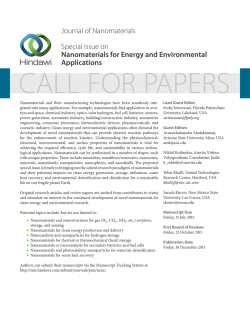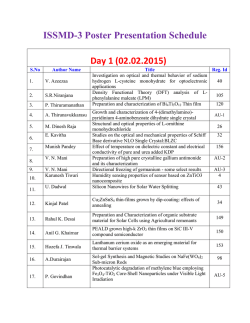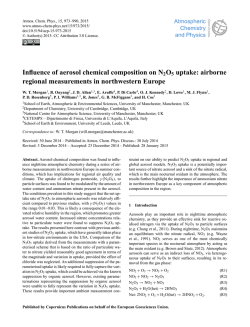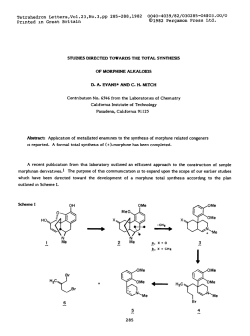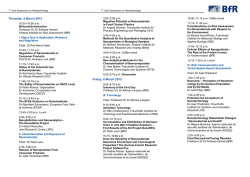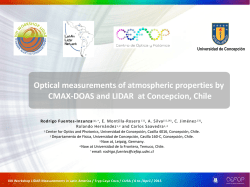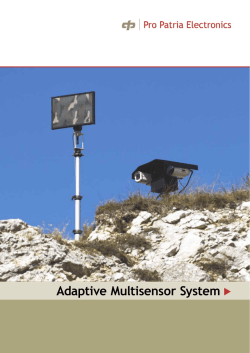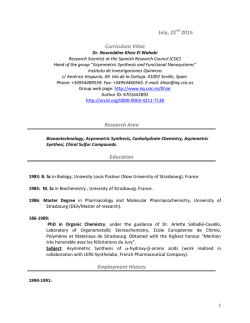
Controlled Synthesis of Nanostructured Particles by Flame Spray
Aerosol synthesis of functional nanomaterials and devices Sotiris E. Pratsinis Department of Mechanical and Process Engineering, ETH Zurich, Switzerland http://www.ptl.ethz.ch/ Gas-phase (aerosol) synthesis of nanoparticles is attractive for manufacturing of nanomaterials as it offers fewer process steps, easier collection from process streams and fewer liquid byproducts than wet-chemistry routes. In addition, it can produce high purity materials (e.g. optical fibers) with unique structure and even phase composition. The lecture will start with a fascinating overview of flame aerosol technology from ancient China to the bible printing by Gutenberg and to the current manufacture of nanostructured commodities (carbon black, fumed SiO2, pigmentary TiO2, filamentary Ni and among others). Recent advances in understanding of combustion and aerosol formation and growth allow now optimal aerosol reactor design and inexpensive production of nanoparticles with sophisticated composition, size and morphology leading to one-step synthesis of multi-metal component heterogeneous catalysts, highly porous, self-assembled lace-like or cauliflower-like and transparent gas sensors, radiopaque but transparent dental fillers and even nutritional products up to 1 kg/h even in academic laboratories! Such units have been built now in UK, Spain and India. The research frontier now shifts to direct fabrication of nanoscale devices by stochastically depositing, above or below a functional nanostructured film, conductive nanoparticles that greatly reduce film resistance. This motivates the development of acetone sensors for early detection and monitoring of diabetes type-1 by breath analysis as well as flexible, multicomponnet and multifunctional nanocomposite films. CV Professor Sotiris E. Pratsinis was born in Chania, Greece has a Diploma in Chemical Engineering from Aristotle University of Thessaloniki, Greece (1977) and MSc (1982) & PhD (1985) in Engineering from Univ. of California, Los Angeles. He was in the faculty (1985-2000) of the University of Cincinnati, USA until elected Professor of Mechanical & Process Engineering (1998) and Materials Science (2003) at ETH Zurich, Switzerland. There he teaches Mass Transfer, Micro- & Nano-Particle Technology, Combustion Synthesis of Materials, and Introduction to Nanoscale Engineering. He has graduated 31 PhDs, published 300+ articles http://www.ptl.ethz.ch/publications/index and has 20+ patents that are licensed to industry and have contributed to creation of four spinoffs. He was one of the first to measure the oxidation rate of TiCl4 for aerosol synthesis of TiO2, a result that has been called a “landmark contribution in the pigment industry”. He developed one of the early simulators for modified chemical vapour deposition of optical fibers that is used in their manufacture till today. He created algorithms for agglomerate aerosol formation, growth and coalescence, for the first time, by introducing the two-dimensional (in particle mass and surface area) population balance equations. This enabled him to extract simpler aerosol models capitalizing on the properties of the self-preserving size distribution. Such models are readily interfaced with fluid dynamics, facilitating systematic process design for aerosol manufacture of nanomaterials as well as a number of commodities (e.g. pigmentary TiO2, fumed SiO2). He has shown experimentally how to closely control aerosol particle size, crystallinity and, for the first time, morphology, from perfectly spherical to highly ramified fractal-like structures. By tracing the end of sintering during aerosol formation, he distinguished quantitatively between (sinterbonded) hard-aggregates and (physically-bonded) soft-agglomerates of nanoparticles, a largely empirical assignment in practice. He and his students developed the flame spray pyrolysis process for aerosol synthesis of films and particles, up to 5 kg/h in his labs, perhaps world’s largest such facility at an academic institution. This has revolutionized the role of aerosol technology in material synthesis by creating an array of new catalysts and sensors and, for the first time, nutritional supplements, battery and dental materials. More recently he is pursuing biomedical applications with the assembly and testing with humans aerosol-made devices e.g. gas sensors for monitoring breath acetone, a tracer for diabetes.
© Copyright 2025
